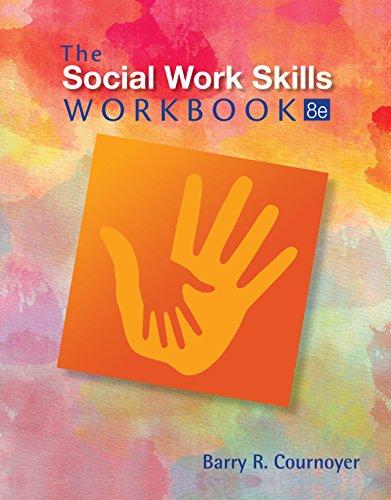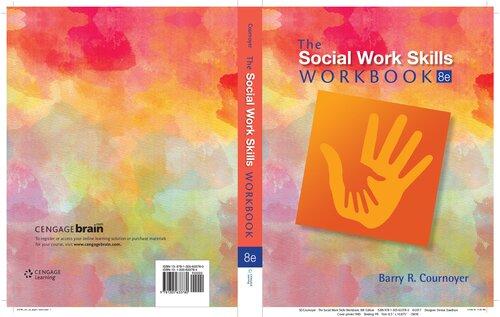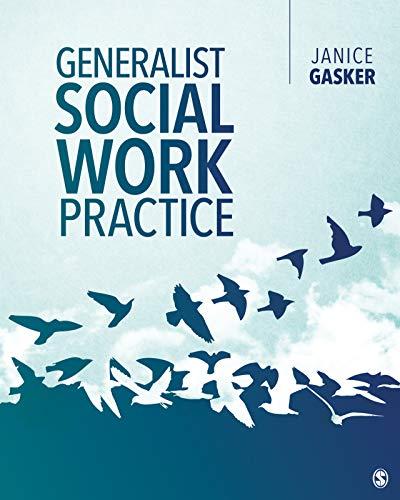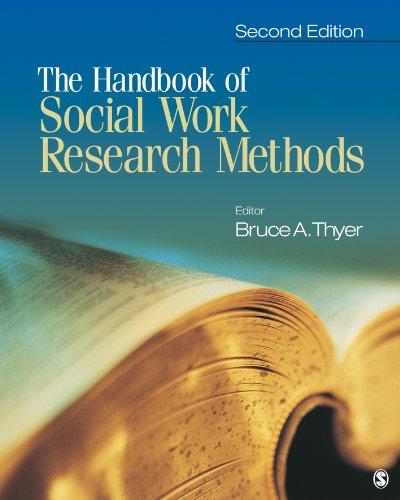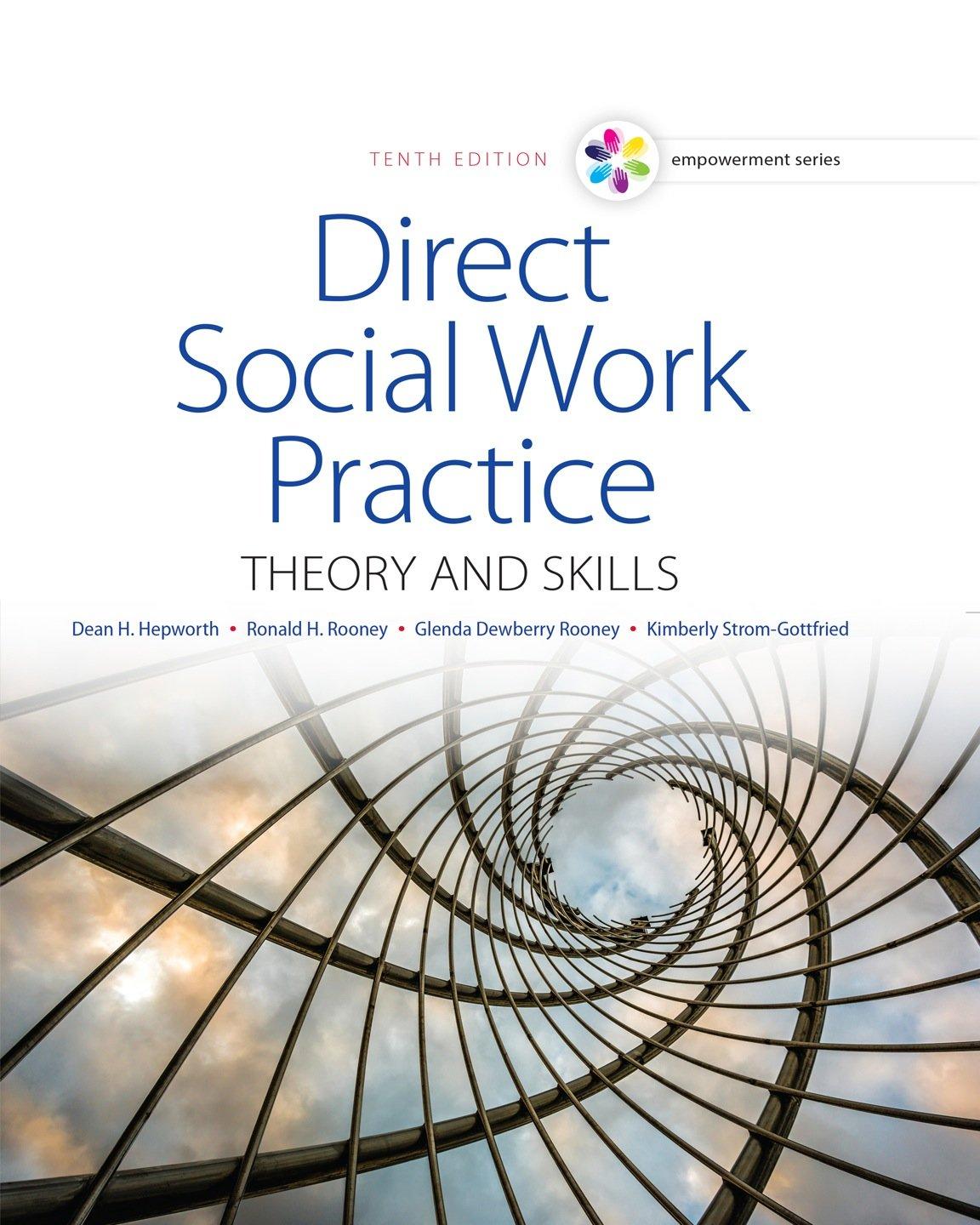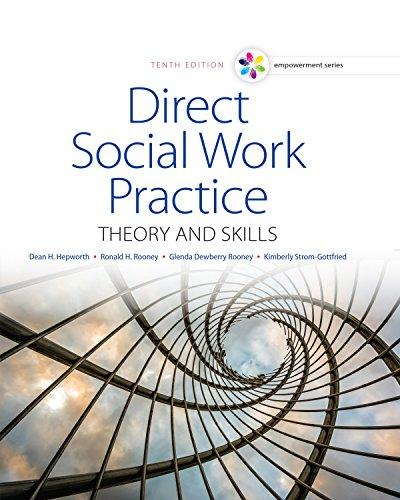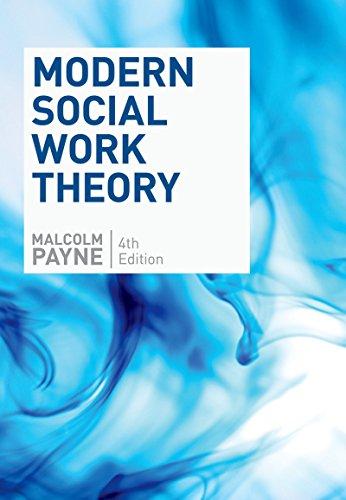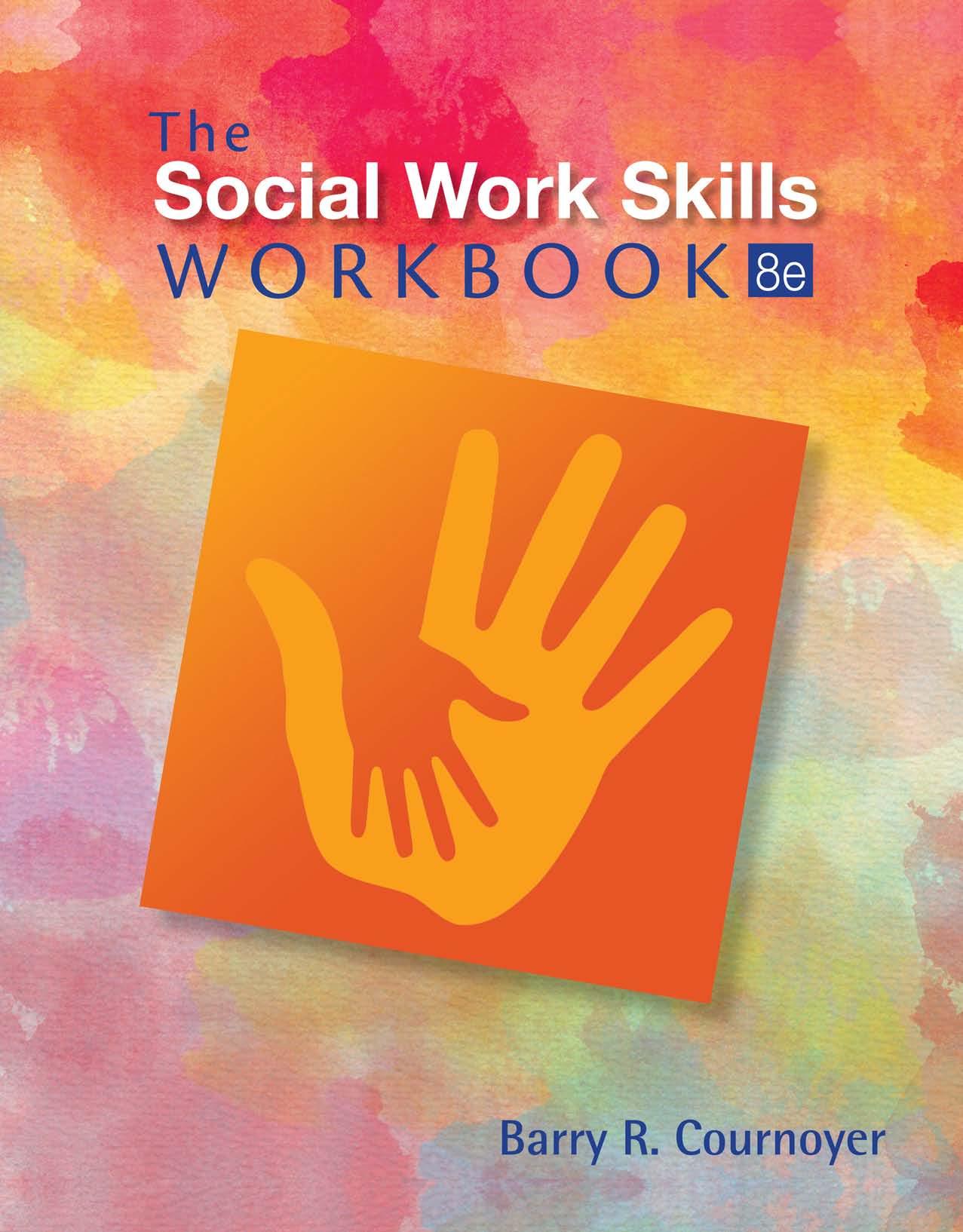The Social Work Skills Workbook 8th Edition – Ebook PDF Version
Visit to download the full and correct content document: https://ebookmass.com/product/the-social-work-skills-workbook-8th-edition-ebook-pdf -version/
More products digital (pdf, epub, mobi) instant download maybe you interests ...
The Social Work Workbook 8th Edition Barry R. Cournoyer
https://ebookmass.com/product/the-social-work-workbook-8thedition-barry-r-cournoyer/
Social Work Practice and the Law – Ebook PDF Version
https://ebookmass.com/product/social-work-practice-and-the-lawebook-pdf-version/
Generalist Social Work Practice 1st Edition – Ebook PDF Version
https://ebookmass.com/product/generalist-social-workpractice-1st-edition-ebook-pdf-version/
The Handbook of Social Work Research Methods – Ebook PDF Version
https://ebookmass.com/product/the-handbook-of-social-workresearch-methods-ebook-pdf-version/
Direct Social Work Practice: Theory and Skills eBook
https://ebookmass.com/product/direct-social-work-practice-theoryand-skills-ebook/
Empowerment Series: Direct Social Work Practice: Theory and Skills 10th Edition, (Ebook PDF)
https://ebookmass.com/product/empowerment-series-direct-socialwork-practice-theory-and-skills-10th-edition-ebook-pdf/
Modern Social Work Theory, Fourth Edition 4th Edition –Ebook PDF Version
https://ebookmass.com/product/modern-social-work-theory-fourthedition-4th-edition-ebook-pdf-version/
American Social Welfare Policy: A Pluralist Approach (Merrill Social Work and Human Services) 8th Edition, (Ebook PDF)
https://ebookmass.com/product/american-social-welfare-policy-apluralist-approach-merrill-social-work-and-human-services-8thedition-ebook-pdf/
Essential Study Skills – Ebook PDF Version
https://ebookmass.com/product/essential-study-skills-ebook-pdfversion/
CHAPTER 6: Summary Exercises 246
Self-Appraisal 248
CHAPTER 7
Preparing 249
Preparatory Reviewing 251
EXERCISE 7-1: Preparatory Reviewing 252
Preparatory Exploring 253
EXERCISE 7-2: Preparatory Exploring 254
Preparatory Consultation 255
EXERCISE 7-3: Preparatory Consultation 257
Preparatory Arranging 258
EXERCISE 7-4: Preparatory Arranging 258
Preparatory Empathy 259
EXERCISE 7-5: Preparatory Empathy 260
Preparatory Self-Exploration 261
EXERCISE 7-6: Preparatory Self-Exploration 261
Centering 262
EXERCISE 7-7: Centering 263
Preliminary Planning and Recording 263
EXERCISE 7-8: Preliminary Planning and Recording 267
Summary 268
CHAPTER 7: Summary Exercises 268
Experiential Interviewing Exercise 269
Self-Appraisal 271
CHAPTER 8
Beginning 273
Introducing Yourself 275
EXERCISE 8-1: Introducing Yourself 276
Seeking Introductions 278
EXERCISE 8-2: Seeking Introductions 279
Describing Initial Purpose 281
EXERCISE 8-3: Describing Initial Purpose 285 Orienting 286
EXERCISE 8-4: Orienting 288
Discussing Policy and Ethical Factors 290
EXERCISE 8-5: Discussing Policy and Ethical Factors 292 Seeking Feedback 294
EXERCISE 8-6: Seeking Feedback 294
Summary 296
CHAPTER 8: Summary Exercises 296
Experiential Interviewing Exercise 297
Self-Appraisal 299
CHAPTER 9
Exploring
Asking Questions 321
EXERCISE 9-1: Asking Questions 324
Seeking Clarification 326
EXERCISE 9-2: Seeking Clarification 328
Ref lecting Content 329
EXERCISE 9-3: Reflecting Content 331 Reflecting Feelings 332
EXERCISE 9-4: Reflecting Feelings 334 Reflecting Feelings and Meaning 336
EXERCISE 9-5: Reflecting Feelings and Meaning 337
Partializing 339
EXERCISE 9-6: Partializing 340
Going Beyond 342
EXERCISE 9-7: Going Beyond 343
Reflecting Issues 344
EXERCISE 9-8: Reflecting Issues 346
Reflecting Hypotheses 347
EXERCISE 9-9: Reflecting Hypotheses 349
Summary 350
CHAPTER 9: Summary Exercises 351
Experiential Interviewing Exercise 352
Self-Appraisal 355
CHAPTER 10
Assessing
Identifying Issues 376
EXERCISE 10-1: Identifying Issues 377
Sharing Hypotheses 379
EXERCISE 10-2: Sharing Hypotheses 389 Confirming Issues 391
EXERCISE 10-3: Confirming Issues for Work 392
Organizing Descriptive Information 393
EXERCISE 10-4: Organizing Descriptive Information 401 Preparing an Assessment and Case Formulation 402
EXERCISE 10-5: Preparing an Assessment and Case Formulation 406
Summary 406
CHAPTER 10: Summary Exercises 406
Experiential Interviewing Exercise 408
Self-Appraisal 409
CHAPTER 11
Contracting
Establishing Goals 412
EXERCISE 11-1: Establishing Goals 418
Developing Action Plans 420
EXERCISE 11-2: Developing Action Plans 423
Identifying Action Steps 423
EXERCISE 11-3: Identifying Action Steps 428
Planning for Evaluation 430
EXERCISE 11-4: Planning for Evaluation 434
Summarizing the Contract 436
EXERCISE 11-5: Summarizing the Contract 437
Summary 438
CHAPTER 11: Summary Exercises 438
Experiential Interviewing Exercise 439
Self-Appraisal 441
CHAPTER 12
Working and Evaluating
Rehearsing Action Steps 445
EXERCISE 12-1: Rehearsing Action Steps 448
Reviewing Action Steps 450
EXERCISE 12-2: Reviewing Action Steps 454
Evaluating 455
EXERCISE 12-3: Evaluating 458
Focusing 459
EXERCISE 12-4: Focusing 460
Educating 462
EXERCISE 12-5: Educating 464
Advising 466
EXERCISE 12-6: Advising 468
Responding with Immediacy 469
EXERCISE 12-7: Responding with Immediacy 471
Reframing 472
EXERCISE 12-8: Reframing 474
Observing Inconsistencies 476
EXERCISE 12-9: Observing Inconsistencies 477
Representing 478
EXERCISE 12-10: Representing 480 Linking 482
EXERCISE 12-11: Linking 484
Pointing Out Endings 487
EXERCISE 12-12: Pointing Out Endings 488
Recording Progress 489
EXERCISE 12-13: Recording Progress 492
Summary 493
CHAPTER 12: Summary Exercises 493
Experiential Interviewing Exercise 495
Self-Appraisal 497
CHAPTER 13
Ending
Reviewing the Process 501
EXERCISE 13-1: Reviewing the Process 501
Final Evaluating 504
EXERCISE 13-2: Final Evaluating 506
Sharing Ending Feelings and Saying Good-bye 508
EXERCISE 13-3: Sharing Ending Feelings and Saying Good-Bye 510
Recording the Closing Summary 512
EXERCISE 13-4: Recording the Closing Summary 513 Summary 513
CHAPTER 13: Summary Exercises 514
Experiential Interviewing Exercise 515
Self Appraisal 517
PART 2 Summary Exercise : Social Work Skills 517 Final Lessons 517
APPENDIX 1: The Social Work Skills Learning Portfolio 519
APPENDIX 2: The Social Work Skills Test 523
The Social Work Skills Test—Part 1 523
The Social Work Skills Test—Part 2 543
APPENDIX 3: The Social Work Skills Self-Appraisal Questionnaire 548
APPENDIX 4: The Critical Thinking Questionnaire 553
APPENDIX 5: The Lifelong Learning Questionnaire 554
APPENDIX 6: The Interview Rating Forms—Client Version 555
APPENDIX 7: Experiential Interview Exercise—Guidelines and Forms 562
Experiential Interviewing Exercise: Guidelines for Interviewing a Practice Client 562
Student Social Worker Consent Form for Experiential Interviewing Exercise 565
Summary Outline of the Multiweek Experiential Interviewing Exercise 566
Social Work Supervisor and Practice Client Advocate: Agreement Form 568
Experiential Interviewing Experience: Guidelines for the Practice Client 569
Practice Client Consent Form for the Experiential Interviewing Exercise 570
APPENDIX 8: Alphabetized List of Feeling Words 571
APPENDIX 9: Description, Assessment, and Contract (DAC): Lynn Chase 577
APPENDIX 10: The Social Work Skills Interview Rating Form 590
APPENDIX 11: Table of Social Work Skills 596
APPENDIX 12: Table of Social Work Skills Supporting the EPAS Competencies 598
APPENDIX 13: Self-Appraisal of Proficiency: EPAS Competency-Based Knowledge and Values, and Practice Behaviors 608
Self-Appraisal of Proficiency: EPAS Competency-Based Knowledge, Values, and Practice Behaviors 609
APPENDIX 14: Self-Appraisal of Proficiency in the ASWB Knowledge, Skills, and Abilities (Bachelor’s Level) 615
APPENDIX 15: Self-Appraisal of Proficiency in the ASWB Knowledge, Skills, and Abilities (Master’s Level) 622
References 631
Index 661
Preface
The original impetus for creating The Social Work Skills Workbook began with observations and, yes, complaints from students that social work professors and their textbooks tend to “talk about practice rather than help us learn what to do and how to do it.” This was a typical comment: “In the classroom, the professors talk at such abstract levels that when I’m with clients, I don’t really know what I’m supposed to do.” Clearly, we needed more practical and applied learning materials.
The eighth edition of The Social Work Skills Workbook addresses these needs and provides opportunities for you to gain proficiency in essential social work skills. While maintaining the general organizational structure of earlier editions, several changes enhance support for the social, economic, and environmental justice mission of the profession and the nature and scope of contemporary social work practice. The integration of the social work skills and the competencies identified in the 2015 iteration of the Educational Policy and Accreditation Standards (EPAS) of the Council on Social Work Education (CSWE) remain evident, as do many of the abilities addressed in social work licensing examinations sponsored by the Association of Social Work Boards (ASWB). Indeed, each social work skill supports one or more of the 43 knowledge and value statements (KVs) and the 31 practice behaviors (PBs) which elaborate the nine core competencies presented in the EPAS. They also address knowledge, skills and abilities (KSAs) contained in the ASWB exams. However, the skills workbook should not be viewed as a manual for the CSWE endorsed EPAS competencies or as a study guide for the ASWB sponsored licensing examinations. The social work skills incorporated here are consistent with the purposes of the profession, its core values and ethics, and findings from the professional literature and scholarly research studies.
Consistent with social work’s person-in-environment perspective, studies that highlight the “power of context” serve to inform the selection of case examples and exercises included in this edition. This edition reflects increased attention to policy–practice and social action, and maintains its focus upon scientific inquiry, critical thought, and
Goals
Following completion of The Social Work Skills Workbook, you should be able to:
Apply the dimensions of professionalism in social work practice.
Think critically in professional contexts and throughout the phases and processes of social work. Engage in scientific inquiry and lifelong learning to seek, discover, evaluate, and apply relevant knowledge in professional practice. Access a place of peace, engage diversity and difference, and accept others in a culturally sensitive and respectful manner. Consider core social work values, ethics, and relevant legal obligations in making ethical decisions and taking ethical action. Demonstrate oral and written communication skills in working with individuals, families, groups, organizations, communities, and societies.
Apply the skills of preparing, beginning, exploring, assessing, contracting, working and evaluating, and ending in your work with and on behalf of individuals, families, groups, organizations, and communities. Engage in policy–practice and social action to advocate for human rights; social, economic, and environmental justice; and social well-being.
Assess and evaluate one’s proficiency in the social work skills. Prepare a Social Work Skills Learning Portfolio to plan, integrate, synthesize, and document lifelong learning for your career in social work.
incorporation of research-based knowledge in collaborative decision making with clients and others. Such emphases reflect current political and socioeconomic conditions as well as contemporary views of evidence-based and outcome-informed practice. Clearly, social workers are guided by practice-relevant, credible research findings. However, we also recognize our human tendencies toward self-affirmation and confirmation bias. Therefore, we consistently seek evidence of progress toward those collaboratively established goals that clients, social workers, and other stakeholders pursue. We engage in continuous evaluation of our work with individuals, families, groups, organizations, and communities to improve outcomes as well as enhance the quality of our service to others.
This edition of The Social Work Skills Workbook may be used (1) as the primary text for social work practice and social work skills laboratory courses (which might be titled “interviewing skills,” “interpersonal skills,” “professional skills,” “interactional skills,” “interpersonal communication skills,” “microskills,” “practice skills,” or “helping skills” labs); (2) as a text for introductory, “immersion,” or professional socialization seminars or modules; (3) as a workbook for social work practice courses; (4) by social work students and field instructors during practicum experiences; and (5) by professional social workers seeking to enhance their professionalism and their proficiency in essential social work skills.
New to the Eighth Edition
Fully integrated with the most recent (2015) iteration of the Educational Policy and Educational Standards (EPAS) of the Council on Social Work Education (CSWE).
Enhanced integration with online resources through MindTap.
More colorful and attractive style, and improved readability.
Increased exploration of social, economic, and environmental justice—including contemporary forms of racism and related topics such as mass incarceration, police misconduct, increasing income and wealth inequality, and political and financial corruption and oppression.
Added emphasis to social and political action, policy–practice, and cause and class advocacy.
Major new case illustration and analysis for the purposes of ethical analysis and decision making.
New, revised, and updated in-chapter and end-of chapter exercises.
Revised assessment content, processes, and skills.
Improved and more detailed guidelines for the five-session experiential learning exercise with a practice client.
The Self-Appraisal of Proficiency of EPAS Competency-Based Knowledge and Values, and Practice Behaviors—Updated and revised.
The Social Work Skills Test—Updated and revised.
Social work programs may use the skills workbook in courses over two terms in their BSW or MSW foundation curriculums. This approach allows students additional time to complete and reflect upon the numerous skill-building exercises, and to refine materials included within their Social Work Skills Learning Portfolios (see Appendix 1) that result from completion of chapter exercises. To facilitate such an option, this edition is organized into two major parts. Part 1: Professionalism introduces students to the values, culture, and context of social work. It contains an introduction and four chapters that address 10 dimensions of professionalism: integrity; self-understanding and self-control; knowledge, expertise, and self-efficacy; social support and well-being; critical thinking and scientific inquiry; lifelong learning; diversity and difference; human rights and social, economic, and environmental justice; policy–practice; and ethical decision making. The exercises contained in Part 1 emphasize these aspects of professionalism and involve scientific inquiry, critical thought and reflection, independent learning, and preparation of several written documents.
Part 2: Social Work Skills emphasizes skills needed for contemporary practice. Part 2 begins with a review of the basic skills of talking and listening followed by chapters that address skills associated with seven phases of practice: (1) preparing, (2) beginning, (3) exploring, (4) assessing, (5) contracting, (6) working and evaluating, and (7) ending. The exercises in Part 2 are competency-based and focus on the development of proficiency in the social work skills.
The Council on Social Work expects programs to assess students’ progress toward the achievement of competencies. Furthermore, programs must use the results of such assessments to improve program quality and educational outcomes. Typically, social work programs expect their students to demonstrate proficiency in most or all of the social work skills reflected in this book. Because each of the social work skills supports one or more of the EPAS competencies, the Social Work Skills Self-Appraisal Questionnaire (Appendix 3); the Self-Appraisal of Proficiency: EPAS Competency-Based Knowledge and Values, and Practice Behaviors (Appendix 13), and items from The Social Work Skills Test (Appendix 2)—especially when used in “before” and “after” fashion— can contribute data for student learning outcome assessment of individual students, student cohorts, and the program as a whole.
The Social Work Skills Test may be used to advance individual student learning or for social work program evaluation. Students may complete some or all test items at the beginning of a course or program of study and then again at the end to provide a direct indication of learning progress. Professors may find students’ responses to the first test administration helpful in determining which skills to emphasize or reinforce during the learning experience.
The Social Work Skills Test contains two major parts. Part 1 includes 140 true-false and multiple-choice items that refer directly to descriptive content contained within the book. These items are written primarily at the comprehension level of intellectual development. In order to answer such items correctly, you must have read, understood, and remembered material presented in the book. Part 2 includes 50 short-answer items through which you apply what you have learned to practice scenarios. More intellectually challenging than Part 1, these items are framed at the application, analysis, synthesis, and evaluation levels of intellectual development. Many of these items approximate contexts and exchanges that commonly occur in social work practice. You must invest considerable thought, judgment, and care in responding to items in Part 2 of The Social Work Skills Test.
Many of the end-of-chapter exercises result in word-processed documents for inclusion in the Social Work Skills Learning Portfolio. As a result, learners naturally create additional relevant information for potential use in outcome assessment—whether that involves self-assessment by learners themselves, or evaluation by their professors, advisers, or the school, department, or educational program. The documents are stored in a designated portion of an electronic storage medium such as a computer hard drive or removable disk. Prepared in word-processed format, the learning portfolio provides ready access to documentary evidence of progress in developing proficiency in the social work skills. The Social Work Skills Learning Portfolio may also be used for self-assessment purposes or by professors to evaluate individual student learning. Social work schools and departments may use the portfolios of student cohorts (or samples thereof) to evaluate the general effectiveness of a course or educational program. Educators may use the assessments and evaluations formatively to identify additional individual or group learning needs, or summatively to determine a rank, status, or grade. When collated and aggregated by class or cohort, responses to self-appraisal questions and test items, and the numerous documents produced for the Social Work Skills Learning Portfolio can help social work programs evaluate progress toward the achievement of their educational goals, objectives, and competencies as part of their effort to improve learning outcomes and meet CSWE accreditation standards.
Some skill-building exercises involve resources available through the Internet, whereas others require personal reflection, self-analysis, or some form of critical thinking and scholarly inquiry. Certain exercises may provoke discomfort as students begin to question or challenge strongly held personal beliefs, attitudes, and ideologies. Indeed, some discomfort may stimulate you to think skeptically and critically about your own ideas and those of others. You might even change your mind about some things you now assume to be true. As social workers, we routinely face extraordinarily difficult and highly stressful situations that challenge our personal views, values, and expectations. We must learn to cope with and manage considerable individual, interpersonal, and social distress as well as a great deal of intellectual ambiguity so that we can maintain primary focus on our clients’ needs and goals, on human rights and social justice, and on our own professional responsibilities.
Please use the exercises in this book to explore and indeed question your assumptions about humans and human behavior, about fairness and justice, and about life and living. Don’t believe everything you think. Appreciate that social work commonly involves complex, deep thinking about personal and social phenomena that often trigger powerful emotions and attitudes. As you use this book, I hope you learn to examine and analyze the underlying assumptions and the nature, source, and quality of the evidence that support the values and ideas that guide your approach to others and the world around you.
The individuals, families, groups, organizations, communities, and societies that social workers serve differ in various ways. As you proceed through the skills book, you will explore problems, issues, and scenarios that reflect diversity and difference as well as some that reveal profound commonalities within our human family. Many exercises address aspects of culture, status, and difference as they relate to policies and practices that affect human rights and social, economic, and environmental justice.
Completion of the learning exercises leads to the preparation of two “case records.” Based on self-understanding gained through various exercises, you prepare the description and assessment sections of your own personal case record. In addition, you produce a more complete and more formal case record in the course of conducting five interviews with a “practice client.” The five interviews provide an opportunity for you to simulate all phases of the working relationship (preparing, beginning, exploring, assessing, contracting, working and evaluating, and ending). In addition to the description, assessment, and contract sections, you also prepare progress notes and a closing summary as you engage a practice client in this intensive practice exercise. Both “case records” represent important written products for inclusion in the Social Work Skills Learning Portfolio.
The cases and situations used as illustrative examples and incorporated within learning exercises come from a variety of service settings and circumstances. Although many of the case vignettes involve interaction with individuals, families, and groups, several relate to work with organizations and communities. The significance of social and environmental factors is reflected as are the interrelationships between people and the environment. Several examples of extra-client systems (for example, referral sources, community resources, or related social systems) are incorporated, and case vignettes are chosen with a view toward diversity of age, gender, sexual orientation, and racial, ethnic, cultural, and socioeconomic status.
Professors who employ the workbook in their social work courses may use the exercises in a variety of ways. As part of a homework or in-class assignment, they might ask students to respond to selected exercises and then call on students to share their responses and discuss the characteristics that account for proficiency. Alternately, professors may assign certain exercises as written homework for evaluation. Numerous opportunities stimulate evaluation processes of various kinds, including self-assessments, peer assessments, and appraisals by instructors. Indeed, professors may use aggregated assessment data to highlight skill areas that need further collective attention or move more quickly through skill areas where proficiency is already high. Similarly, students and
professors may periodically review the Social Work Skills Learning Portfolios for formative or summative assessment purposes.
During classroom meetings, professors may ask students to form pairs, triads, or small groups to carry out selected learning exercises. Role plays in which learners alternately assume the part of client and social worker can be especially effective learning experiences—particularly when there is timely and constructive feedback from the professor. In general, professors should recognize that we use the social work skills in the context of helping people. Therefore, learning processes that approximate the actual doing with opportunities for evaluative feedback are preferred. “Talking about” topics can lead to considerable insight. However, when skills and competencies are involved, doing, applying, and practicing tend to yield a much greater return on our educational investment.
In addition to appendices that pertain to self-appraisal and evaluation tools, other appendices contain materials to support your learning. Within the appendices you will find an interview rating form for clients; guidelines and forms for the multiweek experiential interviewing exercise; an alphabetized vocabulary of English “feeling” words; an example of the Description, Assessment, and Contract (DAC) portions of a case record; a form for assessing skills performance during interviews with simulated or actual clients; a table of social work skills; and a table that links skills to the knowledge and values, and practice behaviors that support the nine core EPAS competencies.
In addition to the appendices, ancillary learning resources are available through the book’s companion website—accessible via the Cengage Learning portal at www.cengage.com.
Ancillaries
MindTap
The Social Work Skills Workbook comes with MindTap, an online learning solution created to harness the power of technology to drive student success. This cloud-based platform integrates a number of learning applications (“apps”) into an easy to use and easy to access tool that supports a personalized learning experience. MindTap combines student learning tools—readings, multimedia, activities, and assessments—into a singular Learning Path that guides students through the course.
Online Instructor’s Manual
The Instructor’s Manual (IM) contains a variety of resources to aid instructors in preparing and presenting text material in a manner that meets their personal preferences and course needs. It presents chapter-by-chapter suggestions and resources to enhance and facilitate learning. Available on the instructor companion site.
Online Test Bank
For supplementary assessment support, the updated test bank includes true/false, multiple-choice, matching, short answer, and essay questions for each chapter. Available on the instructor companion site.
Online PowerPoint Lecture Slides
These vibrant Microsoft® PowerPoint® lecture slides for each chapter assist instructors with their lectures by providing concept coverage using images, figures, and tables directly from the textbook. Available on the instructor companion site.
Acknowledgments
The eighth edition of The Social Work Skills Workbook reflects the experience of some 40 years of social work practice and more than 35 years of university teaching. Over the years, clients and students have consistently been cherished advisors. I am most appreciative of my physically challenged students and clients. Time and time again, they forgave my mistakes, encouraged growth, and inspired awe and reverence.
I am especially indebted to those clients and students who allowed me a glimpse into their worlds. Their life stories are remarkable. I feel privileged to have participated with them in their heroic journeys. Indeed, students in my social work courses have been my most gifted teachers. If they learned half of what I learned from them, I will feel satisfied. I also appreciate the letters and e-mail messages from social work students and professors. I treasure their suggestions for improving the book.
I would also like to recognize those social workers whose teachings and writings have affected me professionally and contributed to the approach taken in this workbook. Dr. Eldon Marshall, my former professor and current friend and colleague, was the first to introduce me to the interpersonal helping skills. I shall never forget his class or the impact of my first videotaped interview. Dr. Dean Hepworth, through both his teaching and writing, furthered the skills emphasis begun during my master’s education. My former colleague, the late Dr. Beulah Compton, also deserves much credit. Her clear conception of fundamental social work processes has served me well indeed. I shall long remember our sometimes heated but always stimulating conversations about social work practice.
I am also grateful to my colleagues at the Indiana University School of Social Work. An extraordinary group of professionals, their dedication to student learning continues to inspire.
I wish to express my appreciation to the reviewers whose suggestions led to improvements in this and earlier editions:
Carolyn Ericson, George Mason University
Kathi Trawver, University of Alaska, Anchorage
Melissa Green, Clark Atlanta University
Debbie Gioia, University of Maryland, Baltimore
Carla Fagan, Methodist University
Antrina Bell, Alcorn State University
Amy Crossland, Lipscomb University
Michele Kelly, University of Mississippi
Finally, I want to thank my mother, Marjorie Murphy Cournoyer, for her love and compassion for others; my late father, Armand Cournoyer, for his courage, determination, and resilience; Karma Hughes and the late Grant Hughes for their unflagging support; and, most importantly, to my loving partner, Catherine Hughes Cournoyer, and our children, John Paul and Michael. Catherine is the most generous person I have ever met and without question the best social worker. Each day, she and the boys continue to make me more and better than I could possibly be without them.
Dedication
I want to dedicate this edition to Native Americans, African Americans, Hispanic Americans, Japanese Americans, immigrants, women, children, and to gay, lesbian, transgender, and all other persons who have been subject to unjustified and inexcusable human rights violations at the hands of dominant forces within the United States. We must make amends for the harm done, and the violence, oppression, incarceration, and abuse must stop!
On a more personal note, I would also like to dedicate this edition to our grandson, Zeke Armand Cournoyer. May his future be characterized by kindness and compassion rather than meanness and judgment; by cooperation more than competition; by peace rather than violence; and by genuine respect for mother earth and the wonderfully diverse forms of life that share her bounties. Barry R. Cournoyer Emeritus Professor of Social Work Indiana University
Other Books by Barry R. Cournoyer
Cournoyer, Barry R., & Stanley, Mary J. (2002). The Social Work Portfolio: Planning, Assessing and Documenting Lifelong Learning in a Dynamic Profession. Pacific Grove, CA: Brooks/Cole. Cournoyer, Barry R. (2004). The Evidence-Based Social Work Skills Book. Boston: Allyn & Bacon. Compton, Beulah R., Galaway, Burt, & Cournoyer, Barry R. (2005). Social Work Processes (7th ed.). Pacific Grove, CA: Brooks/Cole.
professionalism
Chapter 1 Introduction 3
Chapter 2 Introduction to professionalism 17
Chapter 3
Critical Thinking, Scientific Inquiry, and Lifelong Learning 49
Chapter 4
Diversity and Difference; Human rights; Social, Economic, and Environmental Justice; and policy–practice 93
Chapter 5
Social Work Values and Ethical Decision Making 157
Introduction
Welcome to the exciting and challenging world of social work! As a social worker, you may serve individuals, families, groups, organizations, and communities in all kinds of situations. You may do so in direct collaboration with others or indirectly through the development and implementation of policies and programs; organization of groups and communities; leadership of organizations; the design and conduct of socially relevant research studies and evaluation projects; or participation in major social movements intended to resist oppression, safeguard endangered human rights, or advance social, economic, or environmental justice. The range of settings in which you might function is wide and varied. The contexts for social work practice are often complex, usually demanding, and always challenging. Despite the extraordinary demands,
(Continued)
Core Competencies
The content addressed in this chapter supports the following core EpaS competencies:
Competency 1: Demonstrate Ethical and professional Behavior
Competency 2: Engage Diversity and Difference in practice
Competency 3: advance Human rights and Social, Economic, and Environmental Justice
Competency 4: Engage in practice-Informed research and research-Informed practice
Competency 5: Engage in policy–practice
Chapter Goals
Following completion of this chapter, you should be able to:
Describe the mission and purposes of the social work profession.
Discuss the concepts of social work skills and competencies. Identify the phases or processes of social work practice.
Identify the dimensions of professionalism addressed in The Social Work Skills Workbook.
service as a social worker remains a satisfying and personally rewarding endeavor. Social workers often attribute their satisfaction to factors such as the variety of work challenges, the creativity needed to address those challenges, the opportunity to work closely with and on behalf of people— especially people in need—and, importantly, high-quality supervision and positive relationships within their service organizations (Smith & Shields, 2013).
The demands, challenges, and responsibilities of social work service are sometimes daunting. To serve competently in such circumstances, social workers today need to be knowledgeable, thoughtful, ethical, accountable, and proficient. In this chapter, we introduce you to the mission of the social work profession and to our conception of social work skills; outline the phases of practice; and briefly outline the qualities and characteristics of professionalism needed for ethical, effective social work practice in our complex, ever-changing, contemporary society.
The overall purpose of The Social Work Skills Workbook is to help learners develop a strong sense of professionalism and gain proficiency in skills needed for ethical and effective social work practice. These skills are consistent with the raison d’être of the social work profession, its aims, and its values and ethics. Of course, we could not include every one of the various skills that might potentially have relevance for some social workers on certain occasions in some situations. Rather, we address those skills that are (1) most applicable to the social work profession’s mission, purposes, and scope; (2) compatible with and supportive of the phases or processes of contemporary social work practice; (3) representative of the dimensions of professionalism; (4) consistent with social work values, ethics, and obligations; (5) supported by research-based knowledge; and (6) consistent with the competencies, knowledge, values, and practice behaviors identified in the Educational Policy and Accreditation Standards (EPAS) of the Council on Social Work Education (2015) as well as knowledge, skills, and abilities addressed in social work licensing examinations.
The social work skills are organized and presented to coincide with the phases or processes of contemporary social work practice. Of course, any phase-to-phase or stage-to-stage approach runs the risk of suggesting that service to all client systems follows the same linear sequence and that the characteristics and skills relevant to one phase are distinctly different from those of another. This is not the case. Sometimes work usually undertaken in one phase emerges in another, or the sequence must change to address urgent circumstances. In work with a particular client system, many of the dynamics, tasks, functions, and skills applicable to one phase are evident in other phases as well. We typically use certain skills (for example, empathic reflection, questioning, and seeking feedback) repeatedly throughout the course of our efforts with and on behalf of people we serve. Many skills are applied in similar fashion in work with individuals, dyads, families, groups, organizations, and communities. Others must be adapted somewhat to accommodate the size and composition of the client system, or when we are engaged in policy–practice and advocacy. Indeed, reflective thought and sound judgment are vital in the selection and application of skills throughout all phases of practice.
Professionalism is essential precisely because the social work skills cannot and should not be applied mechanically or bureaucratically without careful consideration of the people and contexts involved. Aspects of professionalism, such as integrity, knowledge, critical thinking and scientific inquiry, ethical decision making, recognition of human rights, respect for diversity, and the promotion of social, economic, and environmental justice, serve as the basic foundation and context within which the social work skills emerge (see Figure 1.1). Without such a professional foundation, the skills could easily be used in an insensitive, shallow, inappropriate, untimely, and ultimately damaging manner.
At some point in your career as a social worker, you might serve in a child-protection capacity, responding to indications that a child may be at risk of abuse or neglect. You may
help families improve their child-caring capabilities or serve in the emergency room of a hospital, intervening with people and families in crises. You might lead groups for sexually victimized children or provide education and counseling to abusive or incarcerated adults. You could aid couples in strained relationships or help single parents who seek guidance and support in rearing their children. You may serve people who misuse alcohol and drugs or help family members affected by the substance abuse of a parent, child, spouse, or sibling. You might work in a residential setting for youthful offenders, a prison for adults, or a psychiatric institution.
You might serve in a university counseling center, working with college students, faculty members, and other campus employees. You could help people challenged in some way—perhaps physically or mentally, or both. You might serve in a school system or perhaps as a consultant to a local police department or a state or national agency. You might serve as a member of the armed services— helping soldiers, sailors, marines, airmen, or members of the coast guard and their families. You could work in a mayor’s office, serve on the staff of a state legislator, or perhaps even become a member of Congress yourself.
You may function in a crisis intervention capacity for a suicide prevention service. You could work for a health maintenance organization (HMO), a managed health care system, or an employee assistance program (EAP). As a social worker, you might act as an advocate for people who have experienced discrimination, oppression, or exploitation, perhaps because of racism, sexism, ageism, or dogmatic ideology. For example, you might help lesbian, bisexual, gay, transgendered, intersexed, or asexual people assert their human rights in a hostile social environment. You might take action to prevent human sex trafficking—one of the contemporary forms of slavery. You might organize groups or communities, perhaps help workers create or join labor unions, or lead a social action movement. For example, you might take action to strengthen women’s human rights or perhaps the rights of our descendants to an environmentally secure planet. You could challenge extreme social and economic inequality, protest the militarization of local police departments (Balko, 2013; Balko & Cato, 2006) and police misconduct, or challenge political and financial corruption. You could publicly disagree with certain policies of your government and promote alternative approaches. For example, you might object to the extraordinary rendition of international suspects, the torture of prisoners, the premature use of deadly military force against people who may or may not represent a potential danger to your country at some point in the future, or the use of the death penalty as a form of punishment.
You might engage in social entrepreneurship and create social programs designed to aid people or groups in need. You might analyze policies, conduct research related to various social
Professionalism
Social Work Skills
FIGURE 1.1 Professionalism: Foundation and Context for Social Work Skills
problems, or evaluate the effectiveness and outcomes of intervention programs and practices. You might work with homeless families, runaway youth, or street people struggling to survive through panhandling or prostitution. You might work with people victimized by crime or perhaps with those who previously engaged in criminal activity. You might serve in a domestic violence program, providing social services to people affected by child abuse, spouse abuse, or elder abuse; or you might help those affected by war and violent conflicts. For example, you might help injured or traumatized soldiers recover from the horrors of battle and provide needed support to their families. You could provide psychosocial services to people dealing with a physical illness, such as cancer, kidney failure, Alzheimer’s disease, HIV/AIDS, or Ebola, and help their families cope with the myriad psychosocial effects of such conditions. You might work in a hospice, helping people with a terminal illness prepare for their own death or that of a family member. You could help unemployed and underemployed people find employment or locate needed services and resources by providing information and arranging referrals, or by promoting the creation of additional employment opportunities. You might serve documented or undocumented immigrants, refugees, transients, or migrant workers. You might counsel individuals suffering from a serious mental illness, such as schizophrenia or bipolar disorder, and provide support and education to their families. You could work in an assisted care facility for aged people, leading groups for residents or counseling family members. You might serve in a halfway house, work with foster care providers, or perhaps provide information and support to teenage parents. You might serve active or retired military personnel and their families or work in industry, consulting with employers and employees about problems and issues that affect their well-being during times of economic instability.
In conjunction with affected individuals and groups, you might engage in the design, development, and establishment of organizations that promote social well-being among vulnerable populations and struggling communities. You might consult with or help to facilitate the creation of social or political advocacy groups that promote social and economic justice, or participate in those that need additional support.
The range of settings where you might work and the variety of functions that you could fulfill are mind-boggling. Such breadth, diversity, and complexity can be overwhelming. You may ask yourself, “Can I possibly learn what I need to so that I can serve competently as a social worker in all those places, serving such different people, and helping them to address such complex issues?” The answer to that question is certainly NO!
We could never become truly competent in all the arenas where social workers practice because it would require a greater breadth and depth of knowledge and expertise than any one person could ever acquire. Indeed, social workers need a specialized body of knowledge and skill for each practice setting, each special population group, and each social problem. You cannot know everything, do everything, or be competent in helping people struggling with every one of the enormous array of psychosocial issues. However, you can acquire expertise in those skills that are common to social work practice with all population groups and all problems in all settings. These common social work skills bring coherence to the profession, despite its extraordinary variety and complexity.
a Social Work profession
In addition to applying a common set of skills, social workers tend to approach clients from a similar perspective—one that is reflected in a set of core values and a distinctive language, and epitomized in the name of our profession. Our profession is “social work” and we call ourselves “social workers.” We do not attach “ist” to the end of our name, as do our sister helping
professionals in psychology and psychiatry. Rather, we identify ourselves as “workers.” In so doing, we establish a view of ourselves as equal rather than superior to others; that we work with and on behalf of people; and that we do much more than think, study, and advise—we also take action.
In this context, the terms profession, professional, and professionalism warrant some clarification. A profession is a “vocation or calling, especially one that involves some branch of advanced learning or science” as, for example, the medical profession ( The Oxford English Dictionary [Online], 2014). For many of us, social work is both a vocation and a calling. We sincerely want to help others and are motivated by more than money and status to do so. Although the term professional as used, for example, in the sentence, “She is a professional,” connotes a relatively high social status—as would befit those with advanced learning—many social workers use the term to refer to qualities such as integrity, competence, and conscientiousness rather than as a sign of rank or privilege. In this sense, we distinguish those who have earned a college diploma or advanced degree, or hold a license to practice a profession from those who both possess the relevant educational and legal credentials and regularly perform in a respectful, caring, competent, and ethical manner. The former may be members of a profession while the latter are professional indeed.
Social workers usually refer to the people we serve as clients, consumers, or people rather than patients, subjects , or cases . Social workers also favor the word assessment over diagnosis, study, examination , or investigation . Furthermore, we tend to look for strengths, assets, resources, resiliencies, competencies , and abilities rather than attending exclusively to problems, obstacles, deficiencies , or pathologies . We also commonly adopt helping processes that involve cooperation , collaboration, mutuality, shared decision making, and joint action rather than prescription, direction, or coercion. In addition, we use language that is easily understood by all. Eschewing esoteric terminology, such as is often associated with the legal, medical, and psychology professions, we attempt to speak the “language of the people.” In so doing, we may downplay our special, advanced knowledge and expertise; and underplay our social status to promote a sense of collaboration, equal participation, and mutual respect with clients and other constituents. The active encouragement of equal status with others, reflected in our identity as social workers and our use of the people’s language, is characteristic of most contemporary social workers regardless of practice setting.
Professional social workers have earned a baccalaureate, master’s, or doctoral degree in social work. Usually, we are licensed or certified to practice social work in our locale. We adopt certain common values that pervade all aspects of our helping activities, pledge adherence to a social work code of ethics, and tend to view social work in a manner similar to that reflected in the Global Definition of Social Work of the International Federation of Social Workers (IFSW):
Social work is a practice-based profession and an academic discipline that promotes social change and development, social cohesion, and the empowerment and liberation of people. Principles of social justice, human rights, collective responsibility and respect for diversities are central to social work. Underpinned by theories of social work, social sciences, humanities and indigenous knowledge, social work engages people and structures to address life challenges and enhance well-being. (2014, para. 1)
While our specialized education, subscription to a code of ethics, and public endorsement in the form of legal certification or licensure are similar to that of medical doctors and lawyers, the social work mission is quite different from those professions. Rather than maintaining the status quo, social workers actively seek to “promote social change … and the empowerment and
liberation of people” (International Federation of Social Workers, 2014, para. 1). These are radical and, in some contexts, revolutionary aspirations. In their pursuit, we often risk our jobs and social status, and sometimes even our lives.
Regardless of our practice setting or position, social workers tend to view person-in-environment, person-and-environment, or person-in-context 1 as the basic unit of attention. This too is a radical notion, especially in North America where individuals are commonly viewed iconically as autonomous, independent, and completely free-willed creatures who can readily choose to become whatever and whomever they wish to become, regardless of current or past circumstances. Social workers recognize that the past and present physical and social environments profoundly affect people by influencing their development, their thinking processes and belief systems, their habits and behavior toward others, and their subjective experience. We understand that hurricanes or tsunamis, tornadoes, earthquakes, floods or droughts; war, civil conflict, acts of terror, or crimes of violence; political, cultural, and economic conditions; access to food, clean air, water, and opportunities for training and education impact humans and their thoughts, emotions, and actions. We recognize that the “playing field” is not level and the concept of “equal opportunity” is mythical (Stiglitz, 2013, Feb. 16). In addition, social workers realize that many communities are predisposed to react favorably or unfavorably to individual characteristics clearly beyond anyone’s personal control. Each of us is born with certain genitalia and a particular skin tone. We cannot easily change those; nor can we readily alter our DNA or that of our ancestors. Humans can relocate but we can never change the time and place of our birth nor the communities and cultures of our childhood. We cannot choose to have been born in a time and place of peace when we were not, into a dominant and privileged class when we were not, nor physically beautiful when we were not. As infants, we could not decide upon our ethnicity, religious or nonreligious affiliation, and language, dialect, or accent; nor could we determine how the people around us would respond to our presence. Others might love and cherish us or treat us with disgust and disdain. Their attitudes and behavior were beyond our influence. Many of us were unfortunate and grew up unwanted and unloved in violent, chaotic times and places. Some of us survived and a few thrived. While we celebrate survivors’ resilience and capacity to overcome obstacles and transcend limitations, we recognize that peaceful, loving, resource-rich environments containing wide-ranging opportunities enable people to more readily maximize their potential and fulfill their aspirations than do conflicted, unloving, resource-scarce settings. Social workers resist temptations to blame people—and especially so for circumstances beyond their control.
Recognizing the power of context (Gershoff, Mistry, & Crosby, 2014), social workers consider the enhancement of social functioning and the promotion or restoration of “a mutually beneficial interaction between individuals and society to improve the quality of life for everyone” (Minahan, 1981, p. 6) as an overriding purpose of practice. This consistent dual focus on people and environment leads social workers to consider multiple systems—even when an individual person or family is formally the “client.” Indeed, social workers always consider and usually involve other people or other social systems in the helping process.
In the Preamble to its Code of Ethics, the National Association of Social Workers (NASW) states that:
A historic and defining feature of social work is the profession’s focus on individual well-being in a social context and the well-being of society. Fundamental to social work is attention to the
1 In this book, we use the term person or people in the same manner we use the term client or clients. We recognize that a client may be an individual person or many people. A client might be a dyad, family, group, organization, community, or even a society with which a social worker has an agreement to provide services. Furthermore, in the spirit of the concept person-inenvironment, we always consider clients, indeed all people, within the context of their situation and circumstances.
environmental forces that create, contribute to, and address problems in living. Social workers promote social justice and social change with and on behalf of clients…. Social workers are sensitive to cultural and ethnic diversity and strive to end discrimination, oppression, poverty, and other forms of social injustice. (2008)
In its EPAS, the Council on Social Work Education (CSWE) indicates that:
The purpose of the social work profession is to promote human and community well-being. Guided by a person-in-environment framework, a global perspective, respect for human diversity, and knowledge based on scientific inquiry, the purpose of social work is actualized through its quest for social and economic justice, the prevention of conditions that limit human rights, the elimination of poverty, and the enhancement of the quality of life for all persons, locally and globally. (2015, para. 1)
Notice that the NASW and the CSWE, like the IFSW, endorse a social change–oriented conception of the profession. These organizations suggest that social work’s mission involves the promotion of social, economic, and environmental justice; the enhancement of social well-being and quality of life; and the elimination of “discrimination, oppression, poverty, and other forms of social injustice” (National Association of Social Workers, 2008, Preamble). Such aspirations do not appear in the mission statements or ethical codes of other professions. Social work alone dares to endorse publicly such potentially controversial ideas and to establish them as central to its professional identity, purpose, and raison d’être.
Given our focus on social change, social workers tend to conceive of people and situations as dynamic and as having the potential for planned change. We view professional practice as predominantly for clients: the individuals, families, groups, organizations, communities, and societies that we serve. Whatever personal benefit we might gain is secondary; the notion of service to others is foremost. The primacy of service in social work is reflected through a special sensitivity to those living in poverty; unemployed and underemployed people; vulnerable populations and at-risk individuals; and oppressed peoples. Indeed, people with the lowest status, the fewest resources, and the least power constitute social work’s most cherished constituency.
Many social workers address the most urgent social, economic, and environmental problems facing individuals, families, and communities throughout North America and the world. These include the devastating consequences of apparently endless war (Risen, 2014); state and nonstate sponsored international violence—including the use of assassination, preemptive military strikes, extraordinary rendition, and torture of prisoners (Senate Select Committee on Intelligence, 2014); militarization of domestic police forces, the rise of the “warrior cop” (Balko, 2013), and frequent incidents of police misconduct—especially toward African American, Hispanic, and other “profiled” minorities (Johnson, Hoyer, & Heath, 2014, May 8; Lee, 2014, Aug. 15), and persons affected by mental illness and other disabilities (Mizner, 2015, Jan. 8); disproportionately high rates of incarceration—especially among racial and ethnic minority groups (Alexander, 2010; Henrichson & Delaney, 2012, Jan.); high levels of homelessness (Homelessness Research Institute, 2014); widespread political and financial corruption (Taibbi, 2011); and rising income and wealth inequality along with diminished economic opportunity and decreasing socioeconomic mobility (Krugman, 2014, May 8; Piketty, 2014). Other problems addressed include increased expense and decreased value of several forms of higher education (Arum & Roksa, 2011); apparently increasing self-admiration, narcissism, and materialism among many populations (Campbell, Bush, Brunell, & Shelton, 2005; Twenge, 2006; Twenge & Campbell, 2009); pervasive incivility toward and intolerance of “others” (Bey, 2012, Mar. 2); extensive and growing medicalization of personal and social problems (Szasz, 2007; Whitaker, 2010); deleterious effects of increasing rates of climate
and oceanic change (Hönisch et al., 2012); continued adoption of ideological dogma, violence, and oppression as “acceptable” means to control and subordinate people—especially women and children (Heimlich, 2011); pervasive dissemination of religious, political, and commercial propaganda that distort or oversimplify complex issues (Larsen, 2006; Postman, 1985); and an apparent willingness among many to accept superstitious or opinionated statements and logically irrational arguments as true and factually correct (Jacoby, 2008).
In such perilous times, social workers increasingly recognize the need for social and political action, community organization, and participation in major social movements to address widespread systemic and structural injustice in social, environmental, and economic spheres. And we do so with a growing sense of urgency (Bulletin of the Atomic Scientists, 2015).
There are some signs that “enough is enough.” These include the popular demonstrations of the Arab Spring, which began in Tunisia in December 2011, continued in Cairo, and then spread throughout much of the world (Schiffrin & Kircher-Allen, 2012); the Occupy movements that began in Wall Street’s Zuccotti Park on Constitution Day (September 17) in 2011 (Blumenkranz, 2011); the outrage, emergence of the #BlackLivesMatter movement, and the large demonstrations throughout the United States in response to disproportionate police reactions leading to the deaths of several unarmed African American men (Lee, 2014, Aug. 15); worldwide popular demonstrations in reaction to the killing of 12 people in the January 7, 2015, attack on the Paris headquarters of the satirical magazine Charlie Hebdo; and the nationwide outcry following the June 17, 2015, massacre of nine African Americans in a historic Charleston, South Carolina, church by a 21-yearold proponent of white supremacist ideology (Mazza, Walker, & Chen, 2015, June 17).
Social movements are especially important in light of a growing body of research findings that confirm and illuminate the powerful influence of situational and contextual factors in understanding human experience and motivating human behavior (DeSteno & Valdesolo, 2011; Sommers, 2011). Consistent with social work’s “person-in-environment” perspective, studies that highlight the “power of context,” the “power of place,” and the “power of the social” encourage us to collaborate with others in our pursuit of social change and community well-being. Our consistent use of a person-in-environment perspective, with strong emphasis on the environment, helps social workers avoid the seductive trap of explaining social problems by referencing the individual characteristics or traits of people directly affected by those problems—a phenomenon called blaming the victim (Ryan, 1971, 1976; Savani, Stephens, & Markus, 2011; Valor-Segura, Exposito, & Moya, 2011; Van Prooijen & Van den Bos, 2009).
In service and advocacy activities, we call upon our strengths in scientific inquiry, critical thought, and knowledge of nomothetic2 and ideographic3 research-based findings in collaborative decision making with clients. Despite our knowledge and expertise, however, social workers maintain a strong sense of humility. We recognize that interventions and activities that help many people are sometimes ineffective with a particular person. Therefore, we evaluate progress throughout the course of our work to determine the effectiveness of our collaborative efforts with client systems. Indeed, systematic evaluation of service impact represents a hallmark of professionalism and, when evaluative feedback is shared and discussed with clients, powerfully contributes
2 The term nomothetic refers to research studies that relate to or contribute to general scientific knowledge. In our context, the term applies to research studies that involve groups of participants, often randomly selected and sometimes compared with members of control groups, so that the results or findings may be generalized to a larger population.
3 The term ideographic (or idiographic) refers to studies that pertain to scientific knowledge of a particular or specific kind. In our context, ideographic studies often involve the systematic evaluation of a client system’s progress toward problem resolution or goal attainment. In social work, the most common forms of ideographic research are single-system or N-of-1 studies.
to favorable outcomes (Anker, Duncan, & Sparks, 2009; Lambert, 2010a, 2010b; Miller, Duncan, Brown, Sorrell, & Chalk, 2006; Probst, Lambert, Dahlbender, Loew, & Tritt, 2014).
Especially when combined with lack of critical thought, insufficient knowledge about safe and effective services can result in damage to individuals, families, groups, organizations, communities, and societies. Social workers who think in a naïve, thoughtless, ignorant, egocentric, ethnocentric, xenophobic, or superstitious manner are frequently ineffective and sometimes harmful to others. During an era when personal opinions, popular myths, and “truthiness” are commonly confused with facts, truth, and validity, and ideology is frequently presented as “knowledge,” scientific inquiry and critical thought are vitally important. We desperately need scholarly, rational, reflective, and indeed skeptical social workers to recognize unsubstantiated claims, falsehoods, shams, scams, cons, and quackery—many of which are inflicted upon desperate and highly vulnerable populations. As professional helpers who often serve people and groups on the margins of society, social workers must be adept at scientific inquiry, critical thinking, and lifelong learning—not only for our own welfare but also for the well-being of our clients and communities.
Social workers recognize that professional service to others often involves powerful interpersonal and social processes that have considerable potential for harm as well as for good. We realize that competent practice requires exceptional personal and professional integrity, a highly developed understanding of ourselves, and extraordinary personal discipline and self-control. In particular, social workers must be expert critical thinkers and energetic lifelong learners to make sense of the ever-increasing glut of information—much of it false, misleading, and nonsensical.
A great deal more than good intentions, admirable personal qualities, and compassionate feelings are required. Indeed, as you probably already realize, good intentions can sometimes cause the most catastrophic of consequences (Coyne, 2013). As social workers, we must base our words and actions on professional knowledge; critical thought; social work values, ethics, and obligations; and, of course, the analogous knowledge, thoughts, values, and aspirations of the people with whom we are so fortunate to work.
Social Work Skills
The terms skill and competency have become extremely popular in social work and other helping professions during the past half century. In addition to the emphasis on competencies suggested by the EPAS (Council on Social Work Education, 2015), several social work textbooks incorporate the word skills in their titles (Hepworth, Rooney, Rooney, & Strom-Gottfried, 2013; Ruffolo, Perron, & Voshel, 2015; Shulman, 2012).
Henry (1981) suggests that skills are “finite and discrete sets of behaviors or tasks employed by a worker at a given time, for a given purpose, in a given manner” (p. vii). She (1992) also cites Phillips (1957), who characterizes skill as “knowledge in action” (p. 20). Middleman and Goldberg (1990) describe skill as “the production of specific behaviors under the precise conditions designated for their use” (p. 12).
Notice that these descriptions and definitions refer to action and behaviors. The CSWE adopts a similar approach in their specification of nine core competencies needed by professional social workers. Incorporated in the EPAS (Council on Social Work Education, 2015) graduates of accredited social work programs should be able to:
1. Demonstrate Ethical and Professional Behavior.
2. Engage Diversity and Difference in Practice.
3. Advance Human Rights and Social, Economic, and Environmental Justice.
4. Engage in Practice-Informed Research and Research-Informed Practice.
5. Engage in Policy–Practice.
6. Engage with Individuals, Families, Groups, Organizations, and Communities.
7. Assess Individuals, Families, Groups, Organizations, and Communities.
8. Intervene with Individuals, Families, Groups, Organizations, and Communities.
9. Evaluate Practice with Individuals, Families, Groups, Organizations, and Communities. (p. 8)
Notice how each of the nine competencies begins with an action verb (for example, engage, assess, intervene, or evaluate). The EPAS competencies and the knowledge and values, and the practice behaviors that explicate them, provide a fundamental standard for social work professionals. All accredited BSW and MSW educational programs infuse these competencies throughout their curriculums. In addition, programs may and usually do identify additional competencies to reflect the unique characteristics of their educational missions, the populations and social problems they address, and the social and environmental contexts in which their students and graduates function.
As cognitive and interpersonal practice behaviors, the skills addressed in this book support the competencies, knowledge and values, and the practice behaviors specified in the EPAS. They reflect our fundamental social work values and principles. Although they are usually associated with particular phases or processes of practice, we never view the social work skills as technical activities to complete, robotlike, at exactly the same relative time and in precisely the same way with all clients and all situations. Rather, we select, combine, and adapt specific social work skills to suit the particular needs and characteristics of the person-in-environment. This requires advanced knowledge, professional expertise, and sophisticated judgment. Indeed, social workers think carefully about timing and context as they decide which skills to use and when and how to use them.
The range and scope of skills that social workers might use in the context of service are wide and varied. A “social worker’s skills include being proficient in communication, assessing problems and client workability, matching needs with resources, developing resources, and changing social structures” (Barker, 2014, p. 393).
In addition to supporting the EPAS competencies, the skills addressed in this workbook are also consistent with the most important qualities that employers of college graduates seek in their prospective employees. These include the abilities to “work in a team structure,” “make decisions and solve problems,” “plan, organize, and prioritize work,” “verbally communicate with persons inside and outside the organization,” “obtain and process information,” “analyze quantitative data,” “create and/or edit written reports,” and “influence others.” Employers also prefer candidates who possess “technical knowledge related to the job” and “proficiency with computer software programs” (National Association of Colleges and Employers, 2014).
More specifically, however, the skills addressed in this book serve the tasks associated with seven commonly identified phases of social work practice, and the dimensions of professionalism. As shown in Figure 1.2, these seven phases extend the four outlined in the EPAS: engage, assess, intervene, and evaluate (Council on Social Work Education, 2015).
The preparing, beginning, and exploring skills support the engagement and some of the assessment competencies; the assessing and contracting skills support the assessment competency; and the working and evaluating, and the ending skills support the intervention and evaluation competencies. Furthermore, the skills addressed in this text are applicable to work with individuals, families, groups, organizations, communities, and societies at the micro, mezzo, and macro levels of practice.
We separate the discrete behaviors associated with each phase or process into small, manageable units of thought and action that are consistent with the dimensions of professionalism. Integrated and synthesized in this fashion, they form the social work skills.
For the purposes of teaching and learning, we define social work skill as follows:
A social work skill is a circumscribed set of discrete cognitive and behavioral actions that are consistent and congruent with (1) social work values, ethics, and obligations; (2) research-based knowledge; (3) the dimensions of professionalism; and (4) a legitimate social work purpose within the context of a phase or process of practice.
We also integrate the following dimensions of professionalism in our work with others:
Self-understanding and self-control
Knowledge, expertise, and self-efficacy
Social support and well-being
Critical thinking and scientific inquiry
Lifelong learning
Diversity and difference
Human rights and social, economic, and environmental justice
Policy–practice
Social work values and ethics, and ethical decision making
Each of these dimensions requires integrated knowledge of the values, ethics, and legal obligations that inform our professional decisions and actions. Indeed, the values of the social work profession permeate all aspects of our service.
Social work has a change-oriented mission that includes promoting social, economic, and environmental justice, enhancing social well-being and quality of life, and eliminating discrimination, oppression, and poverty. In pursuit of these aspirations, effective social workers consistently exhibit professionalism throughout the entire helping process—from preparing and beginning on through to the conclusion of work. They appear in our exchanges with other members of client systems, colleagues, referral sources, various stakeholders and constituents, and the public at large. Summary
FIGURE 1.2 Phases and Processes of Practice
